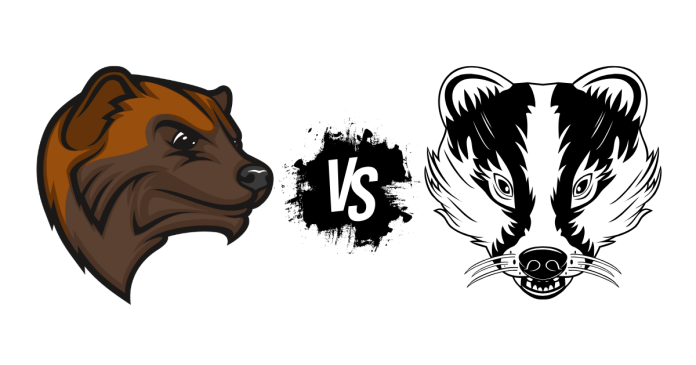Summary Table
| Feature | Wolverine | Badger |
|---|---|---|
| Size | Larger and muscular | Smaller and stockier |
| Habitat | Cold, remote regions | Grasslands, forests, and deserts |
| Behavior | Solitary, aggressive, predator | Diggers, sometimes social |
| Diet | Scavenger and predator | Insects, small animals, roots |
| Temperament | Fierce and fearless | Aggressive when threatened |
| Lifespan | 5–13 years | 9–14 years |
Wolverines and badgers are two fascinating mammals that share some similarities but are distinct in many ways. They belong to the same family, Mustelidae (the weasel family), but differ in size, behavior, habitat, and physical characteristics. Here’s a detailed comparison:
1. Scientific Classification
- Wolverine (Gulo gulo)
- Family: Mustelidae
- Known as the “glutton” due to its voracious appetite.
- Badger (e.g., American badger: Taxidea taxus)
- Family: Mustelidae
- Includes several species like the European badger (Meles meles) and honey badger (Mellivora capensis).
2. Size and Appearance
- Wolverine:
- Larger and more muscular.
- Weight: 20–55 lbs (9–25 kg).
- Length: 26–42 inches (66–107 cm), including the tail.
- Thick, dark brown fur with lighter stripes running down the sides.
- Badger:
- Smaller and stockier.
- Weight: 10–35 lbs (4.5–16 kg).
- Length: 20–35 inches (51–89 cm), including the tail.
- Shorter legs with distinct facial markings (e.g., white stripes in European and American badgers).
3. Habitat
- Wolverine:
- Found in cold, remote regions like the Arctic tundra, boreal forests, and alpine mountains.
- Primarily located in northern North America, Europe, and Asia.
- Badger:
- Found in a wide range of habitats, including grasslands, forests, and deserts.
- Common in North America, Europe, and parts of Africa and Asia, depending on the species.
4. Behavior
- Wolverine:
- Solitary and highly territorial.
- Known for its strength and aggression, often preying on animals much larger than itself.
- Scavenger and predator, feeding on carcasses, small mammals, and birds.
- Badger:
- Mostly solitary but may live in small groups (clans) depending on the species.
- Excellent diggers, using their powerful claws to create burrows.
- Diet includes insects, small mammals, reptiles, and roots.
5. Temperament
- Wolverine:
- Extremely fierce and fearless, capable of defending itself against larger predators like wolves and bears.
- Known for its endurance and hunting abilities.
- Badger:
- Aggressive when threatened but generally avoids confrontation.
- The honey badger, in particular, is famously fearless and resilient.
6. Speed and Strength
- Wolverine:
- Strong and agile, capable of climbing trees and swimming.
- Not as fast but relies on its strength and stamina.
- Badger:
- Not as strong as the wolverine but extremely fast diggers.
- Can run up to 16–19 mph (26–30 km/h) for short distances.
7. Lifespan
- Wolverine:
- Lives 5–13 years in the wild.
- Badger:
- Lives 9–14 years in the wild, depending on the species.
8. Predators
- Wolverine:
- Few natural predators due to its size and aggression. Occasionally predated by wolves and bears.
- Badger:
- Vulnerable to predators like coyotes, eagles, and large carnivores.
9. Distribution
- Wolverine:
- Found in colder climates, primarily in the Northern Hemisphere.
- Badger:
- Found in temperate regions across the globe, from North America to Europe and Africa.
10. Cultural Significance
- Wolverine:
- Known as a symbol of strength and tenacity.
- Often associated with wild and untamed nature.
- Badger:
- Featured in folklore and literature (e.g., The Wind in the Willows).
- Honey badgers are admired for their fearlessness.
Conclusion
While wolverines and badgers share some traits due to their shared family, they are distinct animals with unique physical and behavioral characteristics. Wolverines are known for their strength and endurance in cold climates, while badgers are excellent diggers and more adaptable to various habitats. Both are fascinating creatures that showcase the diversity of the Mustelidae family.



